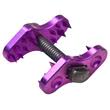 FDA WARNS NUVASIVE OVER ILIF LABELING (Orthopedics This Week)
FDA WARNS NUVASIVE OVER ILIF LABELING (Orthopedics This Week)
The FDA sent NuVasive, Inc. a warning letter on March 12, 2013 related to labeling claims not cleared through any of the company’s Affix Spinous Process Plate system 510(k)s.
The company announced the warning letter on March 18, 2013 and said the regulatory action came from an FDA inspection of the company’s San Diego, California facility last fall. The inspection, according to the company, did not result in any 483 observations nor cite any quality system concerns.
The warning letter only specifies labeling claims related to the company’s ILIF (Interlaminar Lumbar Instrumented Fusion) procedure.
ILIF Procedure
According to the company’s website, NuVasive’s ILIF procedure was developed to overcome the potential shortcomings of standard lumbar spinal stenosis treatments (e.g., decompression alone and decompression with fusion), using a minimally disruptive surgical technique. Minimally disruptive surgical procedures attempt to minimize approach-related muscle pain by avoiding release of the muscle from its bony attachment. The ILIF surgical procedure uses a small incision at the midline of the spine and requires only a small amount of muscle to be detached from both sides of the spinous processes.
ILIF Potential Benefits
The company states that ILIF minimizes destabilization of the spine while utilizing a minimally disruptive decompression procedure called a laminotomy, which involves temporary distraction (opening up) of the space between the spinous processes, and careful removal of only small sections of bone to relieve the pressure on the spinal cord and nerves.
A minimally disruptive stabilization device to help prevent instability following a decompression surgery is used. A small plate is attached to both spinous processes to stabilize the segment of the spine and promote fusion, eliminating the need for more extensive surgery
An interspinous spacer is utilized to provide distraction, decompression, and fusion (growth and connection of two bones). A precision-machined allograft (donor) bone is placed between the spinous processes to accomplish the following:
- Permanently distract (open up) areas that are pressing on the spinal cord and/or nerves. This is known as indirect decompression.
- Promote a fusion (growth and connection of two bones) between the spinous processes to provide long-term spine stabilization.
- Provide a protective cover for the spinal cord to help prevent scar tissue from pressing on the spinal cord and/or nerves.
“Highest Priority”
The company stated that it takes the matter seriously and has already begun to respond to the FDA’s requests. “The Company is giving the matter the highest priority in order to fully address the FDA’s concerns to our mutual satisfaction. As this is an administrative process to address the warning letter, the Company believes the FDA’s concerns can be resolved without an impact on the Company’s financial results or operations,” stated the company news release.
